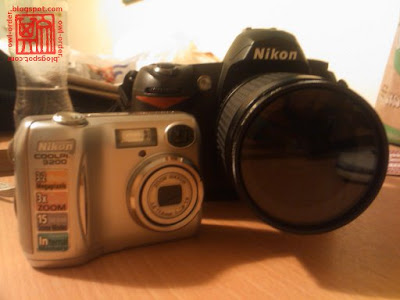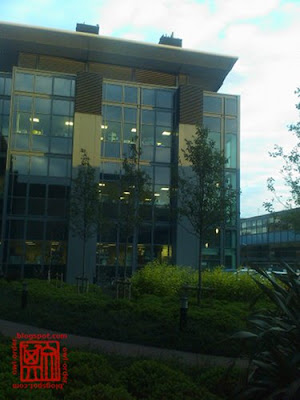Note: High resolution images of some of the following photos are available. These photos are marked with [HiRes] tags in their captions. Click on the photos to view their higher resolution images.
Few weeks ago, I created a blogpost with a seemingly meaningless title, '(ROT13) FYE'. If you were to take time to Google or Wiki ROT13, however, the title becomes crystal clear. If it doesn't, you may have to visit Google or Wikipedia for a second round.
I recently picked up photography, and every single photographer out that dreams of a single, ultimate tool -- the Single Lens Reflex camera, or SLR.

[HiRes] Nikon and Canon are the two leading manufacturers of Digital SLRs. I recently paid a deposit of £80 to loan a Nikon D70s for 10 days.
What are SLRs? Well, to put it in laymen's terms, SLR is a big, ugly, heavy, bulky yet expensive camera. If we have sleek and shiny cameras so much smaller and lighter, why do we still need SLRs?
After loaning an SLR for 10 days (paid £80 deposit) from the university Photosoc, I can tell you, there are many, many reasons SLRs still survive in the market today.

My Nikon Coolpix 3200 and the loaned Nikon D70s. Both are very old cameras released in 2004 and 2005 respectively. It doesn't take a genius to notice the rather poor image quality of this photo as I obviously couldn't use the SLR or Coolpix for this shot.
1. Interchangeable lenses and filters
Needless to say, most SLRs come with interchangeable lens. You can easily equip a general zoom lens for a camping trip. Or pick up a high-quality prime lens (non-zoom lens) for photos with ultra high detail levels. Shooting at night? No fear, grab a fast lens with big aperture. Whether you're shooting something small like an insect or something far like the moon, there are always suitable lenses you can use. Why isn't a single zoom lens enough? The zoom lens is too complicated -- there are too many elements within. The more times you refract light, the lower quality your picture becomes, to put it simply.
Furthermore, you can fit different filters to your lenses for improvement in photo quality or simply to create special effects.
2. Low noise, high sensitivity
Traditionally, cameras use films, typically the size of 36mm by 24mm. When photography gets digitised, films were replaced with digital sensors. Some digital cameras (full-frame cameras) use sensors measuring 36mm wide, but producing such big sensors are expensive (it's common to see full-frame cameras costing more than US$5k), so for compact cameras, small sensors are used (about 5mm width). Using small sensors has another advantage -- lenses can be made smaller too, further minimising the weight and size of compact cameras. However, smaller sensors come with severe disadvantages, including noise, while bigger sensors have much lower noise. This is because the amount of light absorbed is roughly proportional to size of sensor, while noise is relatively unrelated to sensor size.


Left -- 100% crop of an ISO200 photo by my Nikon Coolpix 3200. Right -- 100% crop of an ISO1250 photo by the loaned Nikon D70s. The SLR produces noticeably less noise for more than 6 times the light sensitivity.
Because of the same reason, SLRs have higher light sensitivity (read -- higher ISO), allowing photographs at dimmer conditions.
3. Depth of field (DoF)
Have you ever wondered how professional photographers blur out the background? One can blur out the background by turning on "macro" mode of compacts, but what about bigger objects, such as a person? Macro mode doesn't work further than, say, 20cm away.
SLRs can easily blur out backgrounds (or create bokeh effects) because of their bigger sensors -- their optical infinity is very much larger than a compacts', and blurring can be manipulated easily before infinity is reached. Superzoom cameras can manage a little of this by zooming in, but SLRs are still leagues ahead.
4. Dynamic range (DR)
Have you ever taken a picture only to find that the bright parts are too bright and the dark parts too dark? That's because your camera has poor dynamic range, while human eyes have superb DR. SLRs are still no match for human vision, but they're much better than compacts, thanks again to their bigger sensors.

View from Coates Road Auditorium, University Park Campus, University of Nottingham captured using my Sony Ericsson X1. This picture exhibits rather poor dynamic range and a large amount of flare due to poor sensor and lens quality.

[HiRes] Better dynamic range with much less flaring.
DR of SLR still poor? Hook it up to a tripod, capture a sequence of photos using exposure bracketing, and apply Hi-DR processing on your computer.
5. Speed
How fast does your camera start up? How long does it take for your camera to focus? And to save your captured photo?
SLRs are superbly fast. Startup is fast because the lens is not collapsible, saving the need to expand the lens. Startups usually clock beneath half a second (typically ~0.1s). SLRs use a special focusing algorithm so efficient (phase-detection) auto-focus is done before you can say 'click', literally. Saving photos take such little time it's hard to believe your photos are even saved at all.
6. Battery life
As a compact user, I'm always haunted by the dilemma of whether to keep my compact turned on in case of a photography opportunity or to turn it off to conserve power. Compacts use a lot of power when they're on because they need to provide live-view feedback to the LCD screen. Hence the LCD, sensor, focusing motor, processor and exposure/WB sensor (if any) are all turned on, drawing current from the pathetically small battery.
The days I spend with the SLR, however, I needn't worry about that. Since SLRs don't need the LCD if live view is not used, the sensor is not used until the shot is actually captured. Focusing motor, sensors, mirrors etc all are inactive until the shutter button is semi-depressed. Basically almost everything is turned off before the shutter button is pressed? This explains the SLR's power economy. Added with the bigger battery, SLRs typically last for hundreds of shots (normally >500) in one charge.
The Nikon D70s I loaned lasted for more than 1k photos before screaming for juice.
7. Optical viewfinder (OVF)
The optical viewfinder is the little camera hole you look through when you're taking a picture, before LCD live view became popular. Optical viewfinder is within the definition of SLRs -- both the sensor and the OVF share the same main lenses. OVF is useful because
a) it does not require power to operate and can be used without turning on the camera
b) vision is direct from main lenses, requiring no processing, saving power
c) it does not fade out when operating under bright sunlight
d) it isn't affected by lag or poor refresh rates
8. Flash
Compact Xenon flashes are pathetic, with reaches of, say, 3m? SLR flashes have much further reaches (ie. much brighter), and being positioned higher from the lens, chances of getting red-eyes are reduced.
If, by any chance you would need an even more powerful burst of light positioned even further away from the lens, you can always fit an additional flash gun on your SLR. While front-facing flashes create harsh shadows behind objects, flash guns can be adjusted to fire to the ceiling, lighting the scene from the top, removing the shadows.
I'm not a fan of flash, though.
9. Flexibility
Everything can be tuned. This is in line with traditional pre-digital-age SLRs, allowing the photographer to have everything within his hands.
So you semi-depressed your shutter button to auto-focus, but it locks its focus on the wrong object. Or maybe it flashes a red light and tells you auto-focus failed because it's too dark. While situations like these rarely happen on SLRs, you can always switch to manual focus and problem's solved.

Light-painting can be achieved by using extremely slow shutter speeds. Possible to be created using a decent prosumer/superzoom, though much harder.
SLRs have shallow DoF (shallow focusing). Want deep focusing, like compacts? Just turn the aperture down.
SLRs have lower noise level. Want more noise, like compacts? Don't know why you'd want that, but just turn ISO (light sensitivity) up.
10. Out-of-camera processing
AKA presence of RAW format. Recording in RAW instead of regular JPEG allows processing to be done on the computer instead of in-camera. Parameters like white balance and noise reduction can be tweaked easily this way. Pictures captured using RAW also tend to have higher details than JPEG ones.
There you go. 10 reasons for SLRs after 10 days with one, and I'm not even that experienced a photographer. Sure it's bigger and heavier, but it's a small price to pay for the big jump in image quality. As for price, let's just say the first SLR I was interested in merely cost RM1.7k with a kit lens, the price of a superzoom, perhaps even cheaper -- entry level SLRs offer most (if not all) of the reasons mentioned above.
I miss the D70s already.













PS: bleargh! compact macro. so not professional. so noob.
ReplyDeleteah.. now i understand why u say u no longer have it..
ReplyDeletenice pics :)
bright:
ReplyDeleteah. i miss it =(. ah well.
Beautiful pics!!!
ReplyDeleteGreat post. Thanks for sharing...
ReplyDelete